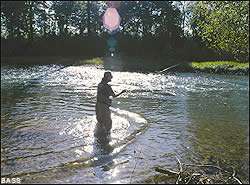
Where bass live in streams
Bass are bass, regardless of where they live. As you've learned from past installments in this series, bass gravitate to cover, structural edges and places where they can find ample feeding opportunities. In a stream, here's where you're most likely to find bass:
Current edges — Largemouth bass usually prefer slack water to current, but in a stream, they'll often locate close to moving water since stream forage normally moves with the current. Smallmouth and spotted bass are more at home in current, and will often hang around shoreline and midstream objects that deflect current flow.
Shoreline wood, rock and weed cover — Submerged logs, laydowns extending off the bank into the water, rocks and aquatic vegetation will all hold stream bass.
Shoals — Smallmouth, especially, will often move onto these shallow structures to forage for crawfish and minnows.
Holes — Good winter and summer stream haunts. Depth is relative; a 3-foot hole in a shallow stream may hold several bass.
Ledges — These depth contours commonly occur in limestone streams. Bass will prowl the ledge when hunting crawfish.
Undercut banks — Important ambush spots for bass. Here, they can tuck into a shaded hiding spot and rush out to grab passing prey.
Midstream cover — Especially good for smallmouth. Current washes around objects on the bottom, often forming a depression in front of the cover, where bass can ambush prey.
Eddies — "Backwashes" where floating debris and injured baitfish gather.
Sand and gravel bars — Prime holding/hunting spots that often combine a current edge with a rapid depth change.
Spillways — Many streams have small dams or spillways; the area immediately above this structure is often fairly deep and may be loaded with submerged wood debris.
Stream lures and tackle
As with any bass fishing scenario, evaluate the depth, current speed, water temperature and clarity of the stream, then choose from the following lure arsenal:
— Grubs are deadly in clear water; they mimic stream minnows. They're also inexpensive to replace should you lose them to snaggy cover. Fish them in holes, around midstream cover and across gravel or sandbars.
— Jigs will catch big largemouth around undercut banks and wood cover. They mimic crawfish, an important stream forage.
— Spinnerbaits work well around shoreline wood and weed cover.
— Buzzbaits are deadly stream lures; fish them around shallow cover early and late in the day.
— Floater/diver minnows should be fished around shoreline cover with intermittent twitches and pauses.
— In-line spinners are excellent in current, but prone to hang-ups. They're a good choice when the stream is high and murky.
— Topwater poppers and chuggers mimic frogs and flying insects that stream bass routinely feed upon.
— Finesse worms, such as the Slider, are underutilized but deadly stream lures. Rig them on a jighead and fish them in any of the spots previously mentioned.
— Soft jerkbaits work great around wood and grass cover.
Avoid ultralight tackle when gunning for stream bass; it lacks sufficient hook setting power. Short rods make it easier to present lures beneath overhanging shoreline cover. A 6-foot medium to medium-heavy spinning outfit with 8-pound mono is a good all-around choice for grubs, small jigs, topwater minnows, poppers and finesse worms. A 6-foot medium action baitcasting outfit with 12-pound line is ideal for spinnerbaits, buzzbaits and jigs.
Fishing streams
Many streams can be accessed on foot. In warm water, you can wade in tennis shoes; in cold water, insulated waders and wading shoes are needed. Move cautiously when wading; stay alert for sudden depth changes and slippery rocks. A wading staff, commonly used by fly fishermen, helps you keep your balance when negotiating rocky streams. Travel light; some anglers use a small backpack to tote a utility tacklebox, water bottle and snack.
Streaming Tips
Catch-and-release is essential to sustaining good stream fishing.




